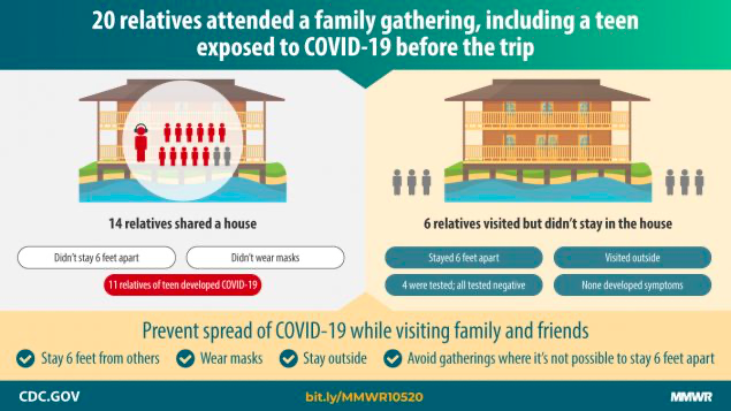Learn more about our FREE COVID-19 Patient Support Program for chronic illness patients and their loved ones.
Experts now know that children and teens seem to spread COVID-19 as easily as adults, but there are precautions you can take when you’re visiting family to protect yourself. And a new case report study reveals that these simple COVID mitigation strategies are effective.
According to a new study in the U.S. Centers for Disease Control and Prevention’s Morbidity and Mortality Weekly Report, one 13-year-old girl spread COVID-19 to 11 family members during an extended family gathering this summer.
Before the gathering, the girl had been away from home and was exposed to the virus during a large COVID-19 outbreak. However, when she received a rapid antigen test four days after exposure, she was asymptomatic and tested negative.
“The adolescent’s initial antigen test result was likely a false negative because it was performed before symptom onset,” note the researchers. “The only antigen test that had Food and Drug Administration Emergency Use Authorization at the time was intended for use within the first five days of symptoms.”
Two days later she developed nasal congestion — her only symptom — and traveled to a gathering of 20 family members with her parents and two brothers.
Fourteen of the attendees at the gathering — ranging in age from 9 to 72 — stayed in a five-bedroom, two-bathroom house for anywhere from eight to 25 days. These family members did not practice social distancing or wear face masks. Among those who stayed in the house, 12 people (including the 13-year-old girl) experienced symptoms and were found to have COVID-19.
One person was hospitalized and another went to the emergency department for respiratory symptoms; both recovered.
Six other relatives (an aunt, an uncle, and four cousins) visited the family gathering for 10 hours on the third day and three hours on the 10th day, when other attendees staying at the house were potentially infectious. These six relatives, however, remained outdoors and maintained a physical distance.
None of those family members developed symptoms, and the four who received COVID-19 tests had negative results.
Key Lessons for People Living with Chronic Illness
This study highlights several important points:
- Kids and teens can be the source for COVID-19 outbreaks within families, even if they have mild symptoms or no symptoms.
- Physical distancing continues to be an effective mitigation strategy to prevent the spread of COVID-19 — and can help protect you if you decide to visit family members.
- Regardless of negative test results, those who know they have been exposed to COVID-19 should quarantine for 14 days, even if they have negative test results.
- COVID-19 can spread quickly during gatherings, especially those with prolonged and close contact. “Gatherings should be avoided when physical distancing and face mask use are not possible,” write the researchers.
- If you’re planning to visit family in the near future or over the holidays, you may be able to do so safely if you follow standard mitigation strategies such as physical distancing (stay six feet from others), wearing face masks, staying outside, and using hand hygiene.
Get Free Coronavirus Support for Chronic Illness Patients
Join the Global Healthy Living Foundation’s free COVID-19 Support Program for chronic illness patients and their families. We will be providing updated information, community support, and other resources tailored specifically to your health and safety. Join now.
Schwartz NG, et al. Adolescent with COVID-19 as the Source of an Outbreak at a 3-Week Family Gathering — Four States, June–July 2020. MMWR Morbidity and Mortality Weekly Report (MMWR). doi: http://dx.doi.org/10.15585/mmwr.mm6940e2.






